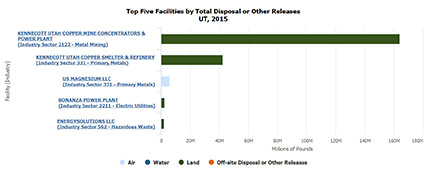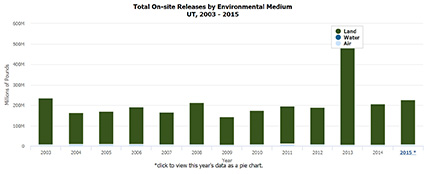By Christine Osborne

The Toxic Release Inventory (TRI) is a public database that chronicles toxic chemical releases, transfers, waste management, and pollution-prevention activities throughout the United States. A recent Forbes article ranked Utah as the third-highest state in the country for toxic releases based on data in the TRI for the reporting year (RY) 2015. These same data ranked Salt Lake County #2 in the nation for total pounds of toxic chemicals released into the environment.
While these rankings may appear alarming at first, the numbers don’t tell the whole story, including what qualifies as a “release” and whether a release poses a health risk to the public. TRI information is most useful when it’s presented in context, including the health effects of the chemical, how the chemical is managed, and whether a relevant human exposure is likely.
DEQ’s Goal: Fewer Toxic Releases
The Department of Environmental Quality (DEQ) takes toxic releases very seriously and works within its regulatory authority to reduce or eliminate chemical releases to the environment.
The TRI is one of the resources we use to track toxic chemical releases and pollution-prevention activities in the state. These data provide us with a starting point for assessing environmental conditions and potential risks to residents. We analyze the TRI to ensure that facilities are meeting their permit limits, make permitting adjustments if releases pose a risk to human health and the environment, and work with industry to reduce the amount of waste generated and implement safer waste-management alternatives.
We know that the public is interested in the information contained in these reports, so we make TRI report data easy to access on our website and Interactive Map.
But what does the TRI really tell us about pollutants in Utah, and what are the benefits and limitations of this information?
The Toxic Release Inventory (TRI)
Congress passed the Emergency Planning and Community Right-to-Know Act (EPCRA) in 1986 in response to concerns about the environmental and safety hazards posed by the storage and handling of toxic chemicals after the disastrous gas leak in Bhopal, India, in 1984. Community Right-to-Know provisions increase the public’s knowledge and access to information on chemicals at individual facilities, their uses, and releases into the environment. States and communities, working with facilities, use the information to improve chemical safety and protect public health and the environment. Section 313 of the Act requires facilities to report their releases to state officials each year.
The TRI tracks the management of certain toxic chemicals that may pose a threat to human health and the environment. Approximately 695 chemicals and chemical categories are included in the reporting list, based on acute or chronic human-health or environmental effects. Facilities that manufacture, process, or otherwise use these chemicals in amounts above established levels must report how they manage each chemical. The information submitted by facilities to the EPA and states is compiled and stored in a publicly accessible database. U.S. facilities in different industry sectors must submit an annual report on:
- The amount of each listed chemical released to the air, water, or soil
- The amount of each listed chemical recycled, treated, or disposed
- Source reduction activities undertaken to prevent pollution
Note: materials on the TRI are “released” when the company that produces or processes them emits them into the air or water or disposes of them in a landfill or similar holding facility.
Benefits and Uses of TRI Data
While TRI data don’t provide a complete picture of the potential impacts of toxic releases, they offer critical information that helps the public, government, and industry make informed decisions about pollutant releases in their communities and prepare for possible toxic releases. For example:
- The public can use TRI data to identify potential concerns
- Governments can use TRI data to compare facilities, identify hot spots, evaluate environmental programs, and establish regulatory priorities
- Industry can use TRI data to establish reduction targets and document progress in reducing chemical releases
Limitations of TRI Data
While the TRI provides data on the annual pounds of each chemical released, transferred, or managed in the state, it misses some important information:
- How toxic are the chemicals?
- What happens to the chemicals in the environment?
- Are people exposed? And if so, what is the potential risk?
The TRI reports releases, not exposures
Release estimates alone are not sufficient to determine exposure, risk of exposure, or calculate potential adverse human health or environmental effects. TRI data do not reveal whether or to what degree the public is exposed to the listed chemicals. TRI data can, in conjunction with other information, be used as a starting point for evaluating exposures and the risks posed by such exposures. The determination of potential risk to human health and/or the environment depends upon many factors, including the toxicity of the chemical, the fate of the chemical in the environment, and the amount and duration of human or other exposure to the chemical.
The EPA uses a Risk-Screening Environmental Indicators (RSEI) model to identify potential health-related impacts of toxic releases from facilities that report to the TRI. The RSEI model provides additional data on environmental fate, exposure, and toxicity information. While the RSEI offers screening information about relative potential for risk, it cannot determine individual exposure or actual risk.
The TRI doesn’t report concentrations
TRI emission totals do not include information on the concentration of chemicals in air, water, or wastes placed on land. A large release may be at a low concentration, and a small release may have a relatively high concentration that makes it more toxic than a larger release. For example, the TRI lists all rock overburden and tailings moved during mining operations as a “release,” so any region with mining operations will rank very high on the list. Mining states with large active mines such as Alaska, Nevada, and Utah have large TRI reporting values, even when the “release” of heavy metals is often still trapped in the rock.
TRI releases are often permitted by state or federal law
TRI releases are often permitted by state or federal environmental agencies after an evaluation concludes that the release will not adversely affect human health or the environment.
TRI Numbers for Utah
About 20 years ago, EPA started listing mine overburden as a release, even though the minerals are still locked in the rock, the material remains on the mine property, and the overburden is subject to stabilization and monitoring. As the graph below demonstrates, 98 percent of Utah’s TRI pollutants are lead and copper compounds in mining overburden.

Kennecott’s movement of mining materials — including waste rock overburden and tailings transported and released within the tailings impoundment — account for a disproportionate amount of the releases reported in the TRI for Utah. More importantly, these toxic “releases” are primarily from land disposal within Kennecott’s permitted facility.
Utah’s TRI numbers will always be high because Kennecott moves large quantities of material each year, and the TRI reports releases in terms of pounds. But that doesn’t mean our residents are necessarily at greater risk. The mining materials at Kennecott contain low concentrations of heavy metals and are subject to permits that require the materials be managed to minimize health impacts.
It’s important to note that TRI totals do not include information on the concentration of the toxics in mining materials. A “large” release under the TRI— measured by the volume of the release (think enormous rocks and large piles of mine overburden) — may in fact contain a small concentration of toxic chemicals. One of the limitations of the TRI is that pounds reported don’t equate to the concentration of chemicals in material, nor do these reported “releases” necessarily result in exposure to the public. In addition, it’s important to remember that the majority of releases, such as those at Kennecott, include properly permitted activities allowable under federal law.
The report also includes waste disposed at commercial facilities, and air emissions from facilities such as US Magnesium and refineries such as Tesoro, Holly, and Chevron. According to EPA’s Risk-Screening Environmental Indicators (RSEI) model analysis of the impacts from TRI releases to air and water reported in 2015, Utah’s RSEI Score ranked 27 out of 56 ranked states and territories. So absent the relocation of solid materials, Utah ranks in the middle nationally for air and water releases.
Total onsite and offsite release amounts from all facilities reporting TRI in Utah increased by 9.7 percent in RY 2015. Total chemical releases to air increased by 30 percent, with total chemical releases to land increasing by 9.7 percent and total chemical releases to water decreasing by 12.8 percent. As the graph below shows, even with these increases, Utah releases are relatively consistent over time. (Note: the large increase in 2013 was due to an 94 percent increase in material moved at Kennecott that reporting year, higher metals concentrations in the ore and waste rock, and a “one-time only” release when the heap leach pad closed).

It is important to note that TRI reporting does not include criteria air pollutants such as PM2.5, since they aren’t categorized as toxic air pollutants. Air toxics, also know as hazardous air pollutants (HAPs), are regulated through National Emission Standards for HAPs (NESHAP).
TRI and Pollution Prevention
The EPA also uses TRI data to track progress in waste reduction to reduce chemical releases. Under the Pollution Prevention Act of 1990, TRI collects information to track industry progress in reducing waste generation and moving towards safer waste management alternatives. Many facilities include measures they have taken to prevent pollution and reduce the amount of toxic chemicals entering the environment in their TRI reporting. In this way, the TRI serves as a tool for identifying effective environmental practices and highlighting pollution prevention successes.
DEQ’s Pollution Prevention (P2) Program supports these efforts by working with businesses to eliminate waste at the source, reduce the amount and toxicity of waste, reuse the waste in their processes, or recycle waste.
A Look Forward
Our mission to safeguard Utah’s air, land, and water through balanced regulation is one we take very seriously. DEQ will continue to work with industry and citizens to reduce toxic releases to protect the health and safety of Utah residents. We encourage your questions and feedback on the TRI and the releases reported in the TRI from the facilities we regulate.
Sources for this blog include the U.S. Environmental Protection Agency (EPA)
Want to learn more about the TRI program in Utah? Check out our website for TRI data summary reports for RY 2000-2015 and a fact sheet with frequently asked questions about the TRI.
Additional information on TRI facilities can be found on the DEQ Interactive Map. Go to “Select Query Layers” on the right-hand side and choose “Environmental Response and Remediation.” Scroll down the dropdown menu until you find “Toxic Release Inventory.” Click on the box. You’ll see a tab below the dropdown menu that asks you to “Define Search Criteria.” Under “Select Search Type,” you’ll find another dropdown menu that lets you search by street address, city, county, or statewide. Once you hit “Search,” you’ll see a map with blue dots for each TRI reporting facility. Click on a dot for more information about the site, including links and related records (you’ll find these search options on the bottom right-hand side of the webpage).
I am a content strategist/communication specialist at the Utah Department of Environmental Quality. I have a Masters in Strategic Communication (MSC) degree from Westminster College and earned my Accreditation in Public Relations (APR) from the Public Relations Society of America (PRSA). I currently teach Integrated Marketing Communication to graduate students in the MSC program at Westminster. In a previous life, I was a bassoonist with the Utah Symphony for 26 years. I love to hike, bike, camp, read, garden, geek out on all things science, and spend time with two college-age sons. I volunteer with a number of local refugee organizations and am currently a teen mentor with the 4-H New American Goat Club and Teen Leadership Club.
